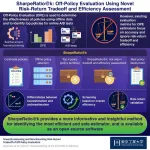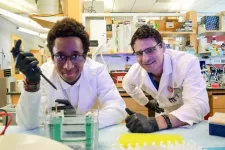(Press-News.org) When it comes to matters of the heart, cardiovascular disease in women is underdiagnosed compared to men. A popular scoring system used to estimate how likely a person is to develop a cardiovascular disease within the next 10 years is the Framingham Risk Score. It is based on factors including age, sex, cholesterol levels, and blood pressure.
Researchers in the US and the Netherlands have now used a large dataset to build more accurate cardiovascular risk models than the Framingham Risk Score. They also quantified the underdiagnosis of women compared to men. The results were published in Frontiers in Physiology.
“We found that that sex-neutral criteria fail to diagnose women adequately. If sex-specific criteria were used, this underdiagnosis would be less severe,” said Skyler St. Pierre, a researcher at Stanford University's Living Matter Lab. “We also found the best exam to improve detection of cardiovascular disease in both men and women is the electrocardiogram (EKG).”
Underdiagnosis due to heart differences
Anatomically, female and male hearts are different. For example, female hearts are smaller and have thinner walls. Yet, the diagnostic criteria for certain heart diseases are the same for women and men, meaning that women’s hearts must increase disproportionally more than men’s before the same risk criteria are met.
When the researchers quantified the underdiagnosis of women compared to men, they found that the use of sex-neutral criteria leads to severe underdiagnosis of female patients. “Women are underdiagnosed for first degree atrioventricular block (AV) block, a disorder affecting the heartbeat, and dilated cardiomyopathy, a heart muscle disease, twice and 1.4 times more than men, respectively,” St. Pierre said. Underdiagnosis of women was also found for other heart disorders.
Old vs new
To achieve more accurate predictions for both sexes, the scientists leveraged four additional metrics that are not considered in the Framingham Risk Score: cardiac magnetic resonance imaging, pulse wave analysis, EKGs, and carotid ultrasounds. They used data from more than 20,000 individuals in the UK Biobank – a biomedical database comprising information from approximately half a million UK individuals aged 40 and older – who had undergone these tests.
“While traditional clinical models are easy to use, we can now use machine learning to comb through thousands of other possible factors to find new, meaningful features that could significantly improve early detection of disease,” explained St. Pierre. Just 10 years ago, these methods were not available, which is why assessment scales like the Framingham Risk Score have been used for half a century.
Using machine learning, the researchers determined that of the tested metrics, EKGs were most effective at improving the detection of cardiovascular disease in both men and women. This, however, does not mean that traditional risk factors are not important tools for risk assessment, the researchers said. “We propose that clinicians first screen people using a simple survey with traditional risk factors, and then do a second stage screening using EKGs for higher risk patients.”
Paving the way for custom medicine
The present study provides a first step into rethinking risk factors for heart disease. Leveraging new technologies is a promising way to improve risk prediction. However, there are some limitations to the study which should be addressed in the future, the researchers said.
One such limitation is the fact that in the UK Biobank sex is treated as a binary variable. Sex, however, is inherently complex, relating to hormones, chromosomes, and physical characteristics, all of which may fall somewhere on a spectrum between ‘typically’ male and ‘typically’ female.
In addition, the study population was middle-aged and older people residing in the UK, so the results may not be transferable to people from other backgrounds and ages. “While sex-specific medicine is one step in the right direction, patient-specific medicine would provide the best outcomes for everyone,” St. Pierre concluded.
END
Women’s heart disease is underdiagnosed, but new machine learning models can help solve this problem
Using machine learning, scientists built more accurate models to predict heart disease risk and found that women are underdiagnosed compared to men, highlighting the need for sex-specific criteria
2024-04-23
ELSE PRESS RELEASES FROM THIS DATE:
Extracting high-purity gold from electrical and electronic waste
2024-04-23
Korea relies on imports for most of its metal resources, and in recent years, due to resource depletion and rising raw material prices, 'circular resources' that recycle waste metal resources have emerged. In response, SK hynix has established a mid- to long-term plan to increase the percentage of copper, gold, etc. recovered and reused from waste generated in the semiconductor manufacturing process to more than 30% by 2030, and Samsung Electronics is running a collection program for used mobile phones in cooperation with E-circulation Governance, a non-profit corporation. The global circular economy market is expected ...
Tropical fish are invading Australian ocean water
2024-04-23
A University of Adelaide study of shallow-water fish communities on rocky reefs in south-eastern Australia has found climate change is helping tropical fish species invade temperate Australian waters.
“The fish are travelling into these Australian ecosystems as larvae caught in the Eastern Australian Current, which is strengthening due to the warming climate,” said the University of Adelaide’s Professor Ivan Nagelkerken, Chief Investigator of the study.
“These larvae would not normally survive in the cooler Australian ...
No bull: How creating less-gassy cows could help fight climate change
2024-04-23
A Curtin University study has revealed breeding less-flatulent cows and restoring agricultural land could significantly reduce rising methane emission levels, which play a considerable role in climate change.
The food system, including grazing animals such as cows, generates major sources of methane mainly due to cattle digestion, manure decomposition and land use for grazing.
To look for solutions, researchers from the Curtin University Sustainability Policy Institute analysed 27 academic publications and identified dozens of potential strategies to reduce methane emissions from Australia’s beef and dairy sectors.
Study ...
ECU researchers call for enhanced research into common post-stroke condition
2024-04-23
Lateropulsion, a clinical condition which results in the body leaning to one side, affects about half of all stroke survivors.
Edith Cowan University (ECU) PhD graduate Dr Jessica Nolan said while the problem is common, lateropulsion is still severely under recognised and under assessed around the world.
“A person with lateropulsion uses the limbs on their stronger side, to push themselves over toward their weaker side. Often those with lateropulsion resist correction back towards their stronger ...
SharpeRatio@k: novel metric for evaluation of risk-return tradeoff in off-policy evaluation
2024-04-23
Reinforcement learning (RL) is a machine learning technique that trains software by mimicking the trial-and-error learning process of humans. It has demonstrated considerable success in many areas that involve sequential decision-making. However, training RL models with real-world online tests is often undesirable as it can be risky, time-consuming and, importantly, unethical. Thus, using offline datasets that are naturally collected through past operations is becoming increasingly popular for training and evaluating RL and bandit ...
$1.8M NIH grant will help researchers follow a virus on its path to the nucleus
2024-04-23
Researchers at the University of Arizona College of Medicine – Tucson were awarded a $1.8 million grant by the National Institute of General Medical Sciences, a division of the National Institutes of Health, to learn how human papillomavirus makes its way to a cell’s nucleus.
Human papillomavirus, or HPV, which can cause warts and certain cancers, has been with us since the dawn of humanity and causes about 5% of cancers worldwide. It also is an important source of information about human biology, according to Samuel K. Campos, PhD, an associate professor of immunobiology at the University of Arizona College of Medicine ...
Follow-up 50 years on finds landmark steroid study remains safe
2024-04-23
A new study has found there are no adverse long-term cardiovascular health consequences for the now-adult children of mothers who were given corticosteroids because they were at risk of early birth in a landmark trial conducted in Auckland, New Zealand, 50 years ago.
The Auckland Steroid Study by obstetrician Professor Graham ‘Mont’ Liggins and paediatrician colleague Dr Ross Howie from 1969 to 1974 in Green Lane Hospital, Auckland, found that two corticosteroid injections given to pregnant women at risk of early (preterm) birth halved the incidence of respiratory distress in the babies and significantly reduced neonatal deaths.
Co-author of the new study, Dr ...
Active military service may heighten women’s risk of having low birthweight babies
2024-04-23
Active military service may heighten a woman’s risk of having a low birthweight baby, suggests a review of the available scientific evidence published online in the journal BMJ Military Health.
The findings highlight the need for more research specifically focused on women in the armed forces, and their reproductive health in particular, conclude the study authors.
Worldwide, increasing numbers of women are on active service in their country’s armed forces. The UK Armed Forces, for example, has set a target of 30% female representation by 2030. And more and more countries are deploying women in combat ...
Significant global variation in national COVID-19 treatment guidelines
2024-04-23
National clinical guidelines for the treatment of COVID-19 vary significantly around the world, with under-resourced countries the most likely to diverge from gold standard (World Health Organization; WHO) treatment recommendations, finds a comparative analysis published in the open access journal BMJ Global Health.
And nearly every national guideline recommends at least one treatment proven not to work, the analysis shows.
Significant variations in national COVID-19 treatment recommendations have been suspected since the advent of the pandemic, but these haven’t been ...
Cost increasingly important motive for quitting smoking for 1 in 4 adults in England
2024-04-23
Health concerns are still the primary motive for more than half of those who say they want to stop smoking in England, but cost is now a key factor for more than 1 in 4, finds an analysis of national survey responses, published in the open access journal BMJ Public Health.
Given this shift in thinking, making much more of the potential savings to be had might encourage more people to stub out for good, suggest the researchers.
Health concerns are generally the primary motive for people trying to stop smoking, with social and ...
LAST 30 PRESS RELEASES:
Heart-brain connection: international study reveals the role of the vagus nerve in keeping the heart young
Researchers identify Rb1 as a predictive biomarker for a new therapeutic strategy in some breast cancers
Survey reveals ethical gaps slowing AI adoption in pediatric surgery
Stimulant ADHD medications work differently than thought
AI overestimates how smart people are, according to HSE economists
HSE researchers create genome-wide map of quadruplexes
Scientists boost cell "powerhouses" to burn more calories
Automatic label checking: The missing step in making reliable medical AI
Low daily alcohol intake linked to 50% heightened mouth cancer risk in India
American Meteorological Society announces Rick Spinrad as 2026 President-Elect
Biomass-based carbon capture spotlighted in newly released global climate webinar recording
Illuminating invisible nano pollutants: advanced bioimaging tracks the full journey of emerging nanoscale contaminants in living systems
How does age affect recovery from spinal cord injury?
Novel AI tool offers prognosis for patients with head and neck cancer
Fathers’ microplastic exposure tied to their children’s metabolic problems
Research validates laboratory model for studying high-grade serous ovarian cancer
SIR 2026 delivers transformative breakthroughs in minimally invasive medicine to improve patient care
Stem Cell Reports most downloaded papers of 2025 highlight the breadth and impact of stem cell research
Oxford-led study estimates NHS spends around 3% of its primary and secondary care budget on the health impacts of heat and cold in England
A researcher’s long quest leads to a smart composite breakthrough
Urban wild bees act as “microbial sensors” of city health.
New study finds where you live affects recovery after a hip fracture
Forecasting the impact of fully automated vehicle adoption on US road traffic injuries
Alcohol-related hospitalizations from 2016 to 2022
Semaglutide and hospitalizations in patients with obesity and established cardiovascular disease
Researchers ‘listen in’ to embryo-mother interactions during implantation using a culture system replicating the womb lining
How changing your diet could help save the world
How to make AI truly scalable and reliable for real-time traffic assignment?
Beyond fragmented markets: A new framework for efficient and stable ride-pooling
Can shape priors make road perception more reliable for autonomous driving?
[Press-News.org] Women’s heart disease is underdiagnosed, but new machine learning models can help solve this problemUsing machine learning, scientists built more accurate models to predict heart disease risk and found that women are underdiagnosed compared to men, highlighting the need for sex-specific criteria



